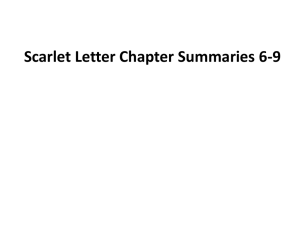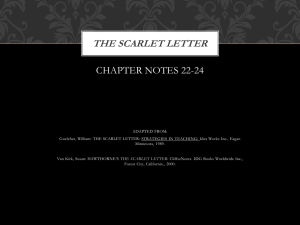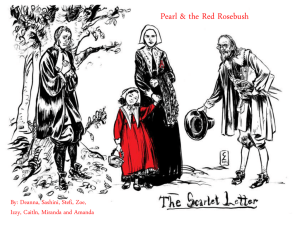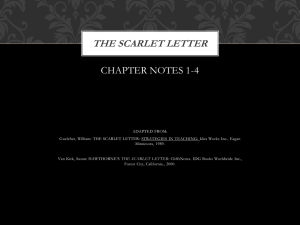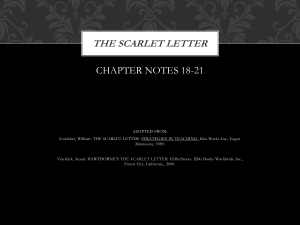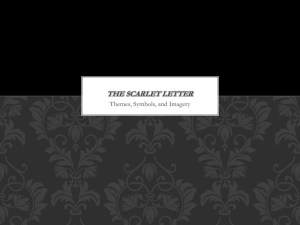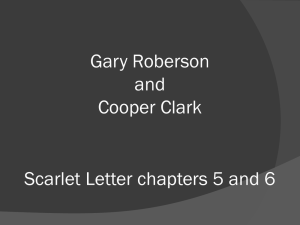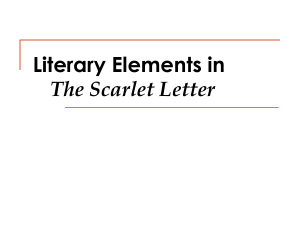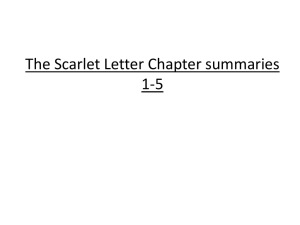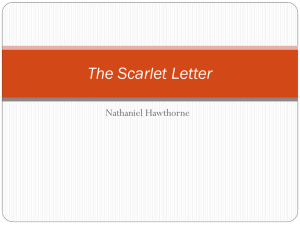Chapters 5-10 - Wayzata Public Schools
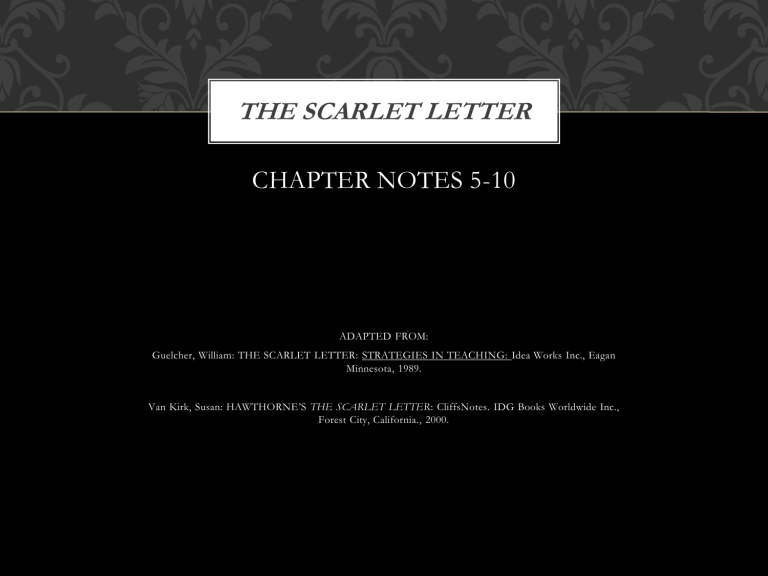
THE SCARLET LETTER
CHAPTER NOTES 5-10
ADAPTED FROM:
Guelcher, William: THE SCARLET LETTER: STRATEGIES IN TEACHING: Idea Works Inc., Eagan
Minnesota, 1989.
Van Kirk, Susan: HAWTHORNE’S THE SCARLET LETTER: CliffsNotes. IDG Books Worldwide Inc.,
Forest City, California., 2000.
BEFORE WE START…A LIGHTER
NOTE
• What’s in a name?
• Roger Chillingsworth
• Roger Cottingworth
• Roger Billiger
• Roger Chillingout
• Richard Cillingworth
• Richard Chilling
• Richard Ellington
• Randy Chillingworth
• Oliver Bellingsworth
• Chillingham
• Thomas
CHAPTERS 5-10
• Hester begins her life as an outcast in a cottage that separates the town from the wilderness
• She is completely isolated – just as she was on the scaffold in the first chapter – as “the figure, the body, the reality of sin.”
• Hester could flee from her letter; she does not.
• Along with the rest of her life,
“…her sin, her ignominy, were the roots which she had struck in the soil.”
CHAPTERS 5-10
• The big question: Should this place be the scene of her earthly punishment as a decree from
God?
• Or should this be the place where she would work out the new purity which was more “saint-like, because of the result of martyrdom?”
• As a result of her sin, does
Hester Prynne actually become a person morally superior to the person she was before?
CHAPTERS 5-10
She carves out an existence for her and Pearl through her needlework, which is in great demand (except for wedding garb).
Irony: The town condemns Hester while seeking the garments she makes: For her part, Hester is not overly proud of her handiwork. She sees the ornamentation as sin.
Remember how ornate her own scarlet letter is.
She also donates much or her earnings to charity.
CHAPTERS 5-10
• Key theme: the scarlet letter – what it represents – separates Hester from society, but it allows her to recognize sin in the very same society that banishes her.
• This represents the hypocrisy of
Puritanism
• Whenever Hester is in the presence of a person masking a sin, “the red infamy upon her breast would give a sympathetic throb.”
• This concerns her: Focusing on the sins of others may tempt her to
“devalue” her own.
CHAPTERS 5-10
• Pearl
• So named because she came of a
“great price”
• A character and a symbol
• Complex: an almost unworldly, beautiful, radiant child whose uncontrollable nature reflects the sinful passion that led to her birth.
• “She is the product and symbol of an act of adultery, an act of love, an act of passion, a sin, and a crime.”
• She is the devil’s child and God’s child.
CHAPTERS 5-10
• The Puritans saw extramarital sex as something inherently evil.
• So Hawthorne raises the question: Can something good come from something evil?
CHAPTERS 5-10
• Consider Hawthorne’s take on the treatment of Hester by the town compared to her treatment by God.
• “Man had marked this woman’s sin by a scarlet letter, which had so potent and disastrous efficacy that no human sympathy could reach her, save it were sinful like herself.”
• Yet, “God, [who] as a direct consequence of the sin which man thus punished, had given her a lovely child…o be finally a blessed soul in heaven!”
CHAPTERS 5-10
• Pay attention to the scarlet references and connection to
Pearl in chapter 7
• Pearl’s dress is scarlet, which seems to intensify her “fire and passion.”
• Pearl’s scarlet appearance is closely associated with the scarlet letter on Hester’s dress, with which Pearl is fascinated.
• The town perceives Pearl as
“the scarlet letter in another form.”
CHAPTERS 5-10
• Chapter 8 reunites the four major characters for the first time since the first scaffold scene.
• What are the solid hints here that reveal Pearl’s father?
• Hester’s appeal to him for help;
Pearl’s solemn caress of his hand; his answering kiss.
• Hester insists Pearl would be better served if Hester is able to teach her wisdom and help Pearl learn from Hester’s sin.
CHAPTERS 5-10
• What does Pearl answer when Mr.
Wilson asks, “Canst thou tell me, child, who made thee?”
• Pearl’s refusal to correctly answer the catechism question: reminiscent of
Hester’s defiance on the scaffold when she refused to name the father of her child.
• Pearl’s existence has a dual nature: happiness and torture for Hester.
• Matthew 13:45-46: The story of a merchant who sold all his goods for one pearl of great worth, which represents the kingdom of heaven.
• Pearl may find salvation, according to
Dimmesdale. Is he prophesying about his own need?
CHAPTERS 5-10
• Two sources of evil appear:
Mistress Hibbins and
Chillingworth.
• Hester notes Chillingworth’s changed physical appearance: now more ugly and dark.
• Chillingworth hints that he may already have decided on
Dimmesdale’s guilt.
• In the end, the forces of light and darkness are vying for human souls.
CHAPTERS 5-10
This is an important juncture: Hester and Dimmesdale stand as contrasting characters.
She publicly acknowledges her sin and accepts the painful consequences: She chooses to keep open the channel of God’s redemption.
Dimmesdale, by keeping his sin private, chooses to alienate himself from God. He is deteriorating because of this decision.
CHAPTERS 5-10
• This battle of good versus evil carries through Chapter 9.
• The town is split on
Chillingworth: Some people initially see him as a “brilliant acquisition” for the ailing
Dimmesdale. But some also suspect Chillingworth is leading to Dimmesdale’s deterioration.
• The “leech” seems to be sucking the life out of the minister.
• By doing so, he strikes up a relationship with evil.
CHAPTERS 5-10
• By Chapter 10, Chillingworth’s evil determination is in full bloom.
• Dimmesdale’s struggle within himself is destroying him, physically and emotionally.
• Chillingworth – once a “pure and upright man” – is now doing the work of the devil through his psychological torture of
Dimmesdale: The minister cannot serve his fellow man with dark secrets in his soul.
CHAPTERS 5-10
• The mysterious reference to
Dimmesdale’s chest at the end of the chapter: an important “clue” and confirmation that
Chillingworth has found the man he has been looking for.
• Note Hawthorne’s take on the
“strange sympathy betwixt the soul and body” – the external representation of the inner character.
• The major characters are symbols, as well as people.
